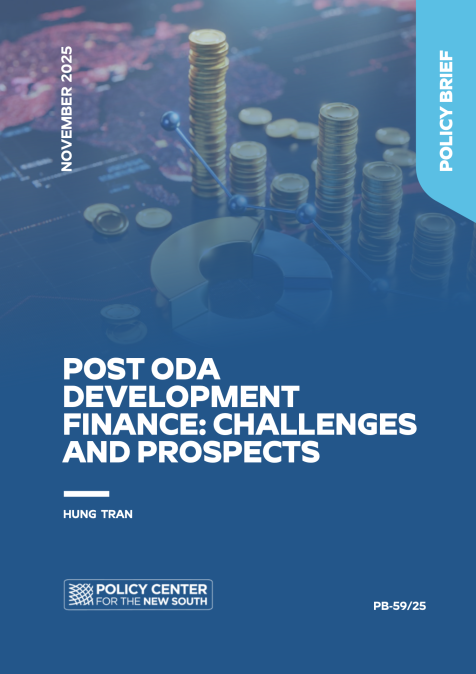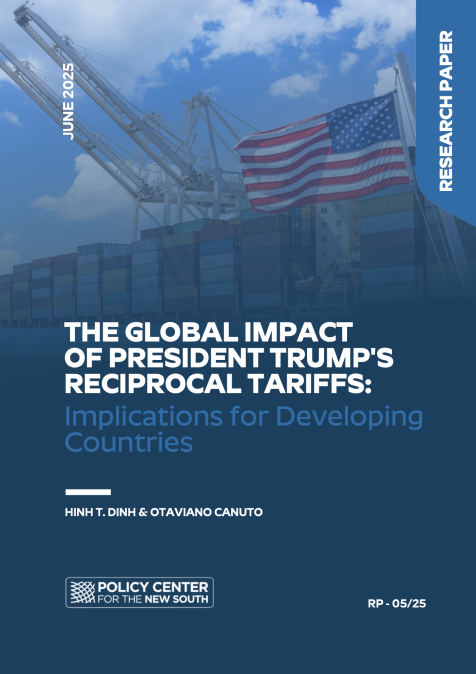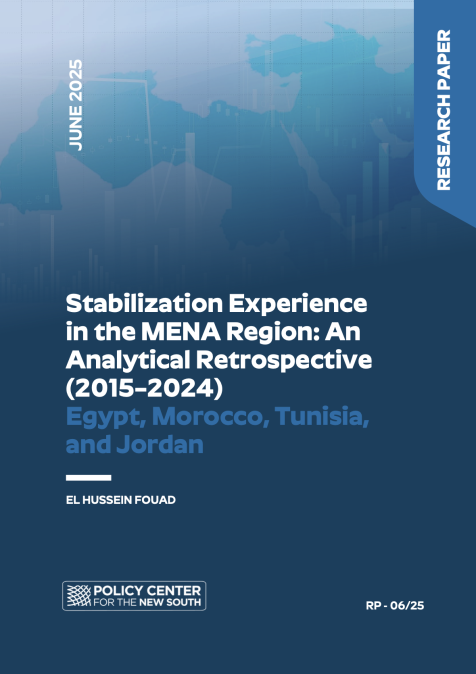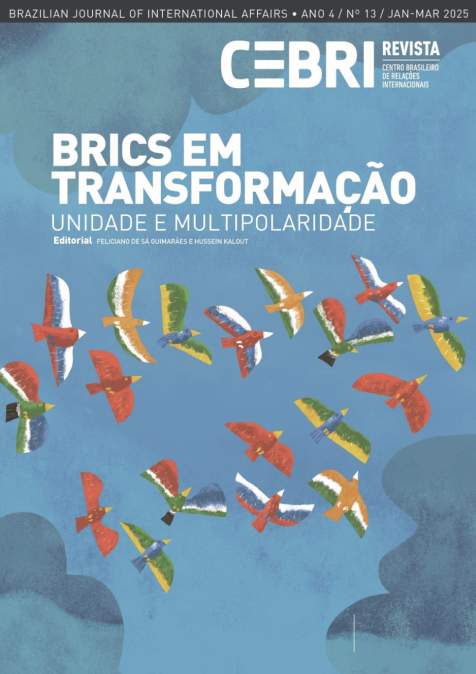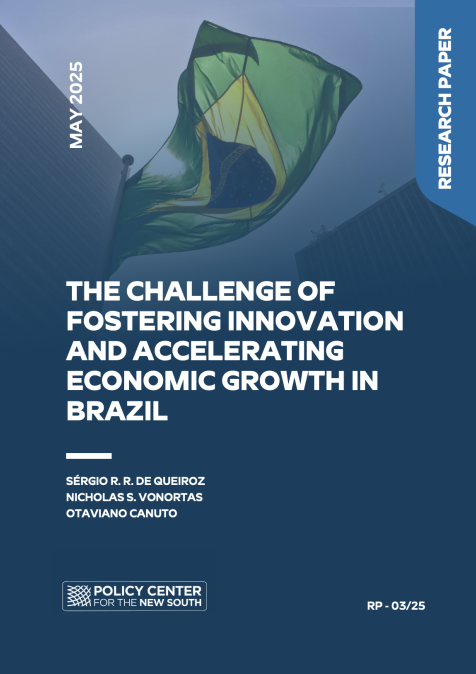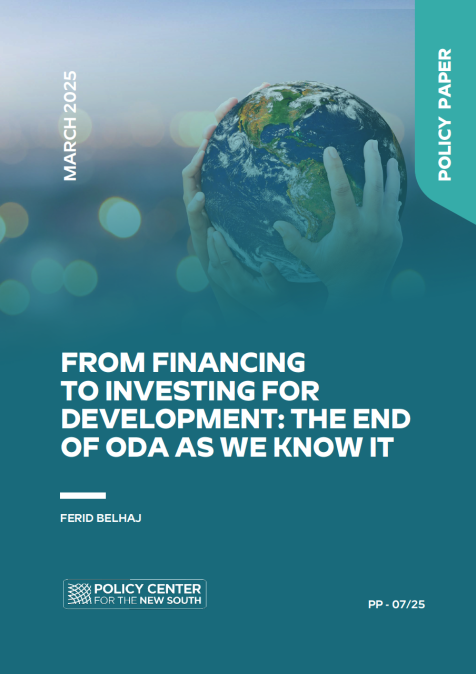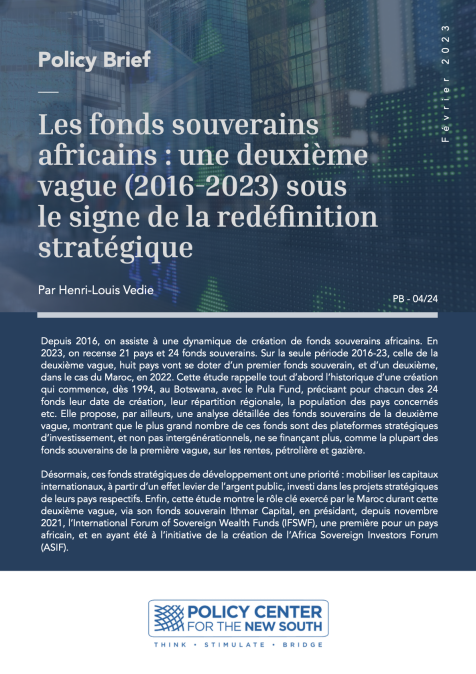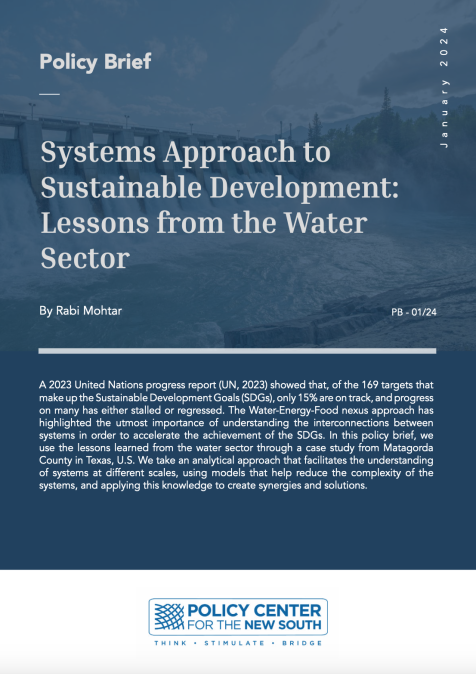Publications /
Policy Brief
Official Development Assistance (ODA) to developing countries has fallen in recent years to well below the UN target of 0.7% of developed countries’ gross national income. Global remittances have become the biggest inflow to poor countries, greater than ODA or foreign direct investment which has also declined. Against the backdrop of geopolitical tension between major powers, other countries including developing ones and development institutions have to do their parts in mobilizing development finance to assist low income countries. The challenge in doing so remains formidable in the foreseeable future.
Introduction
As a result of ongoing geopolitical rivalries, there has been a sharp decline in the official development aid (ODA) provided by developed countries—particularly the 33 members of the OECD’s Development Assistance Committee (DAC)—to developing and low-income countries (LICs). The annual volume of ODA has fallen in recent years as governments in many developed countries face growing and competing demands on their budgets, especially for national security and defense. This trend accelerated in 2025 with significant cuts to the U.S. aid budget, including the dismantling of the US Agency for International Development (USAID).
The annual volume of ODA appears to have peaked in 2023 at $223 billion—equivalent to 0.37% of Gross National Income (GNI)—well below the ODA/GNI target ratio of 0.7% recommended by the United Nations in 1970 and meant to be achieved by 1975. Since 2023, ODA has declined by 25%, reaching an estimated $167 billion in 2025 (or 0.30% of GNI), and it is likely to fall further in the foreseeable future. It is important to note that ODA to developing countries has . Consequently, net ODA to LICs has fallen below their foreign debt service payments, according to the International Monetary Fund (IMF).
Furthermore, an increasing share of budgeted ODA has been used by several donor countries to cover the costs of processing incoming refugee flows—further reducing the amount of development aid actually reaching poor countries. For example, the UK allocated about 28% of its ODA budget to refugee-related expenses in 2023. Several other developed countries have done the same—to the detriment of LICs.
It is important to note that in 2023, considerably less than the $82 billion going to middle-income countries (MICs). More importantly, development aid has become less anti-poverty focused in recent years. Specifically, between 2018 and 2023, the aid-weighted average GNI per capita of recipient countries rose from 1.8 times the LIC average to 2.2 times. This practice should be changed, and LICs should be given priority over MICs.
As an illustration of recent developments, Africa has seen its share of ODA decline since 2020 to less than $70 billion in 2023. Furthermore, foreign direct investment (FDI) to the continent has also declined irregularly since 2010—from more than $100 billion in 2010 to less than $20 billion in 2020—recovering somewhat to below $60 billion in 2023. This track record of lackluster FDI inflows to Africa has highlighted the limited success of initiatives promoted by developed countries and multilateral development banks (MDBs) to use public investment to catalyze private investment in LICs. Offsetting these shortfalls to some extent has been the steady rise in remittances, which reached $90 billion in 2023—making them the largest financial inflow to Africa.
How to Deal with ODA Cuts
The reduction in international development aid has been harmful to LICs, severely straining their public services and further disrupting the already meager provision of health care. Many countries—especially the so-called middle powers in both the global North and South—have lamented the aid cutbacks by the advanced economies and called for a revival of ODA. Interestingly, while many officials in LICs have appealed for the restoration of aid, several leaders have instead advocated turning crisis into opportunity, urging LICs to rise to the occasion, put their houses in order, and improve the quality of government spending to help themselves. Regardless of perspective, the challenge of mobilizing sufficient development finance to assist developing countries will be formidable in the years ahead.
MDBs as the First Line of Defense
Against the backdrop of ODA cutbacks, the first line of defense in providing development assistance to developing countries is the MDBs, spearheaded by the World Bank (International Bank for Reconstruction and Development Group). Together, MDBs have provided developing countries with concessional loans worth around $100 billion a year. Since the MDBs’ calls for capital increases are unlikely to be met—given the current geopolitically driven re-prioritization of government budgets already burdened by substantial deficits—it is important that MDBs optimize the use of their balance sheets, in line with the G20’s Independent Review of MDB Capital Adequacy Framework (2022).
For example, by lowering its minimum equity-to-loans ratio requirement from 20% to 18%, implementing various guarantee schemes with shareholders and the Asian Infrastructure Investment Bank, and attracting 14 shareholders (so far) to its hybrid capital instruments, the World Bank could potentially increase its lending capacity by up to $100 billion over 10 years while preserving its AAA credit rating. More broadly, Standard & Poor’s has estimated that through balance sheet optimization, major MDBs could extend an additional $600-800 billion in development loans while maintaining AAA ratings. Given the current budget constraints, these potential increases in lending capacity would be of great value to LICs—if realized and used effectively.
MDBs should also continue to develop risk-sharing schemes and instruments to attract private investment to the development projects they sponsor, especially in LICs. Despite repeated and optimistic statements by politicians, the private capital mobilization multipliers of MDB lending remain low—averaging just 0.5x—meaning that each dollar of MDB lending has catalyzed only half a dollar in private investment, according to the Institute of International Finance. To strengthen their efforts to mobilize private investment, MDBs should intensify their collaboration with LDCs to improve business conditions, enabling them to attract more FDI as well as domestic investment.
More importantly, MDBs should reconsider their current practice of providing 70% of their lending to MICs, and reorient their financial and technical resources toward LICs. They should accelerate the graduation of MICs—especially upper-middle-income ones—from the ranks of development aid recipients. Since this aligns with U.S. policy priorities and would benefit a large number of LICs, many in dire circumstances, such a shift should be readily implementable.
In this context, it is worth noting that the latest replenishment of the International Development Association’s (IDA) budget for concessional loans and grants to LICs—known as IDA21—has been successfully concluded at a record level of $100 billion. Since its founding in 1960, the IDA has given $533 billion in assistance to 115 LICs. The Trump administration included a $3.2 billion contribution to IDA21 contribution in its budget bill to Congress—a slight reduction from the $4 billion pledged by the Biden administration in 2024.
Contribution from Private Philanthropy
Private philanthropic foundations have made a small but valuable contribution to international development finance. According to a recent OECD analysis of 205 foundations worldwide, they provided $42.5 billion during 2016-2019, averaging $10.6 billion per year—equivalent to about 7% of ODA during the same period. It is interesting to note that more than half of this contribution came from U.S.-based foundations, while 116 foundations in the sample were based in emerging market countries, providing $7.9 billion in development finance. It is reasonable to expect that development finance flows from private foundations will remain stable in the foreseeable future.
Middle Powers Should Put Money Where Their Mouths Are
Secondly, other countries—especially middle powers that have advocated for more development aid from advanced countries—should take greater responsibility for sustaining development aid flows. They appear to have done so by steering the Fourth International Conference on Financing for Development (FfD4), held in Seville, Spain, in mid-2025, toward consensus agreements following the U.S. withdrawal.
As the first intergovernmental conference since 2015 to address the estimated $4 trillion annual financing gap required to help developing countries achieve the UN Sustainable Development Goals (SDGs), the FfD4 succeeded in adopting two key documents: the Seville Commitment (to catalyze investment at scale, tackle the debt crisis, and reform the international financial architecture) and the Seville Platform for Action, which includes 130 voluntary initiatives by governments, international organizations, and private entities to promote worthwhile projects such as private investment, resilient financing, taxation of high-net-worth individuals, and the establishment of a sovereign borrower club.
Participants at the FfD4 appear generally satisfied with these results. However, it is important to recognize that these “commitments” are vague and voluntary, lacking any enforcement mechanism to ensure implementation. Consequently, the FfD4 risks perpetuating the disappointing track record of many previous international conferences—over-promising and underdelivering. In fact, the outlook for the FfD4 could be even bleaker without the active participation and leadership of the U.S., historically the largest donor in such initiatives.
Fully taking into account the current disarray in international relations, these countries should avoid grandiose visions and instead focus on concrete initiatives and projects with clear, achievable deliverables. These would likely be second-best solutions compared with initiatives enjoying strong multilateral support—which are no longer feasible—but they are also more realistic and have better chances of being implemented. Most importantly, these countries should put money where their mouths are.
Despite frequent statements about South-South cooperation, contributions from Global South countries have accounted for only about 10% of total development aid—compared with their share of global GDP exceeding 40%. This disparity is often cited to justify their calls for greater voice and representation in international organizations such as the IMF and the World Bank. Notably, the equivalent ODA/GNI ratio of major Global South countries remains extremely low: 0.01% from Indonesia, Mexico and Argentina; 0.02% from Brazil; 0.03% from China; and 0.04% from India. The major Global South countries should aim to raise their contribution share to at least 20% of total development aid.
South-South Technical Cooperation Can Be Useful
Even more importantly, many MICs in the Global South can strengthen their technical cooperation with LICs by sharing their development experiences and know-how across various sectors. Their advice may be more relevant and practical for other developing countries, given the similarities in their social and economic conditions compared with advanced economies. Such cooperation has already proved valuable to recipient countries.
For example, India has taken a strategic approach to South-South cooperation, particularly through its Indian Technological and Economic Cooperation (ITEC) program, launched in 1964. India has emphasized capacity building by providing training courses and scholarships to professionals from developing countries. A key focus has been sharing its experience in developing public digital infrastructure, which has supported the creation of its digital identity program and real-time payment system, the United Payment Interface (UPI)—now leading the world in real-time payment transactions. These initiatives have significantly improved payment services and the delivery of public benefits to poor populations, while reducing incidences of corruption.
Kenya re-launched its Technical Standing Committee on South-South Cooperation in 2022 to better coordinate its technical cooperation projects with other developing countries. Known as the “Silicon Savannah” of East Africa for its progress in financial technology, Kenya has shared its experience with the M-Pesa mobile payment platform and e-banking systems, which have enhanced financial inclusion.
Brazil has also been active in South-South technical cooperation through its Brazilian Cooperation Agency, sharing its expertise in agricultural technology, food security, and effective public policy with other developing countries. Notably, Brazil has emphasized that the effectiveness of its cooperation initiatives stems from its own transition from aid recipients to aid provider, enabling it to engage more effectively with partner countries.
Morocco has leveraged its strengths in agricultural technology and renewable energy to provide technical assistance in these areas to other African countries. Generally speaking, South-South technical cooperation projects such as these can be cost-effective, delivering tangible improvements to recipient communities while aligning with donor countries’ strategic interests—thus helping to build domestic support for such programs.
LICs Should Do More to Help Themselves Through Digital Technology
Thirdly, LICs can and should do more to help themselves. They need to mobilize domestic resources and make better use of the funds they already receive from sources other than ODA. Most notably, remittances from their citizens working abroad have become a vital source of external finance. Global remittances were estimated to reach $905 billion in 2024—a 4.6% increase from 2023. By comparison, FDI to developing countries fell by 2.4% to $854 billion in 2024. In particular, remittances to Africa (around $90 billion) far exceeded FDI and ODA flows, each amounting to about $60 billion. However, the cost of sending remittances remains too high—averaging 6% globally and 9% for Sub-Sahara Africa. LICs can help their citizens get more value from remittances by upgrading and digitalizing their payment systems, drawing on the experiences of India and Kenya.
In general, LICs can leverage digital technology to overcome structural barriers such as deficient infrastructure—especially in transportation—to improve access to public, financial, and other essential services. This would also enhance financial inclusion, particularly for underserved segments of the population. Furthermore, LICs could strengthen their public administration by adopting digital technologies and developing public digital infrastructure, following examples of e-government practices implemented in countries such as India, Estonia, and Mongolia. These practices can help enhance tax administration and collection—enabling LICs to approach the average tax revenue-to-GDP ratio of 15% observed in developing countries, as recommended by the IMF—while also improving the delivery of public benefits to eligible citizens. In the process, inefficiencies, waste, and corruption can be reduced, leading to better governance and improved livelihoods.
More generally, public digital infrastructure can promote entrepreneurship and business activity, creating jobs and stimulating economic growth. This can be achieved by developing a variety of digital platforms to support e-learning, telemedicine and health care, e-agriculture, microloans, and insurance, among others. The availability of such services—and the business opportunities they generate—would enable many citizens, especially young people, to participate in the formal economy, acquire new skills, and secure decent employment. The World Bank has demonstrated how digital transformation can drive development in Africa; these examples can be replicated elsewhere across the developing world.
Promoting an efficient and timely sovereign debt restructuring framework for LICs
In recent years, LICs have been heavily burdened with debt—not only external but increasingly domestic—reaching 51-55% of their GDP. Importantly, their annual debt services have increased, with the median level of debt services to budget revenues ratio having reached 16%. This has crowded out other necessary public programs including healthcare and education. Any debt relief for LICs would be helpful given the current severe budgetary constraints—a goal that the international community can agree on even in the current geopolitical tension.
In this context, it is important that the gradual progress made by sovereign debtors and creditors in the framework of the Global Sovereign Debt Roundtable (GSDR) be accelerated and put into practice to improve the sovereign debt workout process. At its latest meeting in October 2025, the GSDR agreed to give practical considerations to operationalize timely information sharing among participants in the restructuring process and to facilitate parallel instead of sequential negotiations. These technical improvements could help avoid delays and promote a timely restructuring deal which is beneficial to creditors and debtors, especially the LICs.
Conclusion
Against the backdrop of intensifying geopolitical rivalry among major powers, other actors—particularly middle powers, LICs, MDBs, and private philanthropy organizations—should play their part in addressing the tightening resource envelop for development finance. This can be done mainly by optimizing the use of aid and prioritizing LICs over MICs. More broadly, the traditional mindset that views development finance primarily through the lens of global commitments and conventional subsidies needs to be revisited. As economist Dani Rodrik argues, local solutions should be sought to address global challenges, since much “can be done at the national level and below, with policy makers acting for the benefit of their immediate constituencies.” If LIC governments, with external assistance, succeed in multiplying the local successes already identified, perceptions of aid and technical cooperation can improve—enhancing the sustainability and impact of such projects.
In line with the “local solutions” perspective discussed above—and particularly in light of the growing tendency to view aid through a transactional lens, as a foreign policy instrument serving the strategic interests of donor countries—it is crucial that the locally led development (LLD) approach remains a central element of the development agenda. Although progress in advancing this approach has been “steady but slow,” it continues to demonstrate its value. This is an important consideration for countries that still hold the view that supporting the development of LICs would benefit the global economy, including their own. Essentially, the LLD approach allows local stakeholders—government, business, civil society, academia, and others—to drive the development of their own country rather than being controlled by donor countries. This approach tends to produce development projects that are suitable for local conditions, more likely to enjoy local ownership, and with better chances of being successfully implemented.
Finally, government officials and leaders of development institutions should reconsider whether they could accomplish more by spending additional time ensuring the execution of well-conceived development projects, rather than jetting around the world from one international meeting to another, making promises that cannot be fulfilled.

